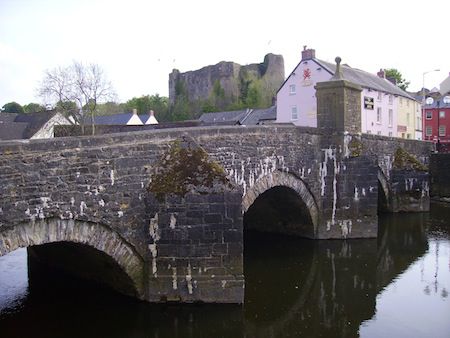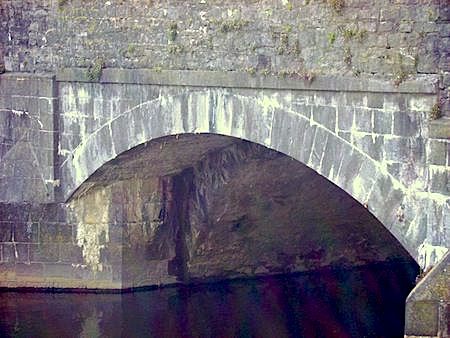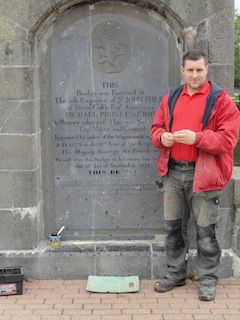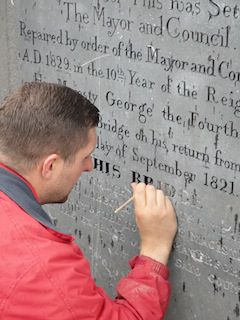Old Bridge, Haverfordwest
16th January 2015

General view of the Old Bridge which includes the importance of the castle overlooking it
The name of Haverfordwest has variously been suggested as having been derived from Hafna’s Ford, Haefer’s Ford and other variations; (the ‘west’ was added much later to distinguish it from Hereford.
Whatever the name origins are, the position that is occupied by the Old Bridge, was the first fordable point on the Cleddau at low tide, and was one of the principal reasons for the Flemings choosing the site for their settlement nine hundred years ago. Added bonuses were that the slab of rock that overlooked it was crying out for a castle to be built on it and at high tide medieval ships could navigate up to this point allowing trade to flourish. After surviving repeated attempts by the Welsh to evict both the Normans and Flemings the town became established and wealthy.
For almost six hundred years all trade coming or going to the quayside crossed a wooden bridge at this point. Quay Street and Bridge Street were joined and formed the main thoroughfare, there being no Castle Square or Victoria Place, or New Bridge.
In 1726 Sir John Philipps of Picton Castle paid for the construction of the Old Bridge. Sir John, known as ‘Good Sir John’ promoted education, sponsoring many schools and even paying poor parents to allow their children to attend school. He also sponsored Non Conformity and financially helped religious reformers of the time, most notably the Moravians, who used to have a church at the top of the town.
In 1821 George IV went over the bridge which was thought worth recording – I’m not sure why. George IV was the one who had to take over when his father George III became mentally ill - and was the Prince Regent. His younger brother was the father of Victoria. He became obscenely obese and was exceptionally unpleasant. Shortly after his coronation he visited Ireland. It was a brief visit and on his return he came via Haverfordwest – not out of choice but because of poor weather at sea.

This shows the original span and arch
In 1848 the bridge was widened. If the underside of the bridge is examined – which you can do from the lower position, it is possible to see the original span – which is by our standards incredibly narrow.
The inscription on the monument on the bridge was something of a contentious affair. Weathering had made the lettering on it almost illegible and neither the County Council nor Haverfordwest Town Council showed itself willing to renovate it...despite both being approached by myself personally and later, Haverfordwest Civic Society.
The message on it states the following;
This bridge was erected at the sole expense of Sir John Philipps of Picton Castle Bart Anno 1726.
Michael Prust Esq Mayor
In memory thereof this was set up by
The Mayor and Council.
Repaired by order of the Mayor and Corporation
AD 1829 in the 10th year of the Reign of
His Majesty George the Fourth who
passed over this bridge on his return from Ireland
the 13th day of September 1821.
This Bridge
was widened and repaired in the year 1848
under the instruction of the magistrates
of the County of the town of Haverfordwest
at the expense of the said County.

This is Jamie Bennett, monumental mason, who effected the renovations over the course of several weeks
A cause for celebration on the last day of August, in an almost deserted Haverfordwest, was in my finding a young man named Jamie Bennett busily painting the lettering on the monument. Jamie is one of the directors of a monumental mason business in Milford Haven who had been commissioned to cut deeper into the engraved message and paint the letters....exactly what I and the Civic Society have been trying to get done for fifteen years.

Jamie Bennett, monumental mason, again, in action on the lettering
Jamie was able to point out the different hands who over the centuries had added to the inscription educating me into the fact that the first light cutting had added to the erosion problems whereas the incredibly deep last four lines in Times Roman had seen little wear and needed only cleaning and tidying.
Jamie wasn’t sure, but suggested a name that points to The Perrot Trust having been asked to undertake the work. I suppose it shows that if you keep pushing, something will eventually be done.